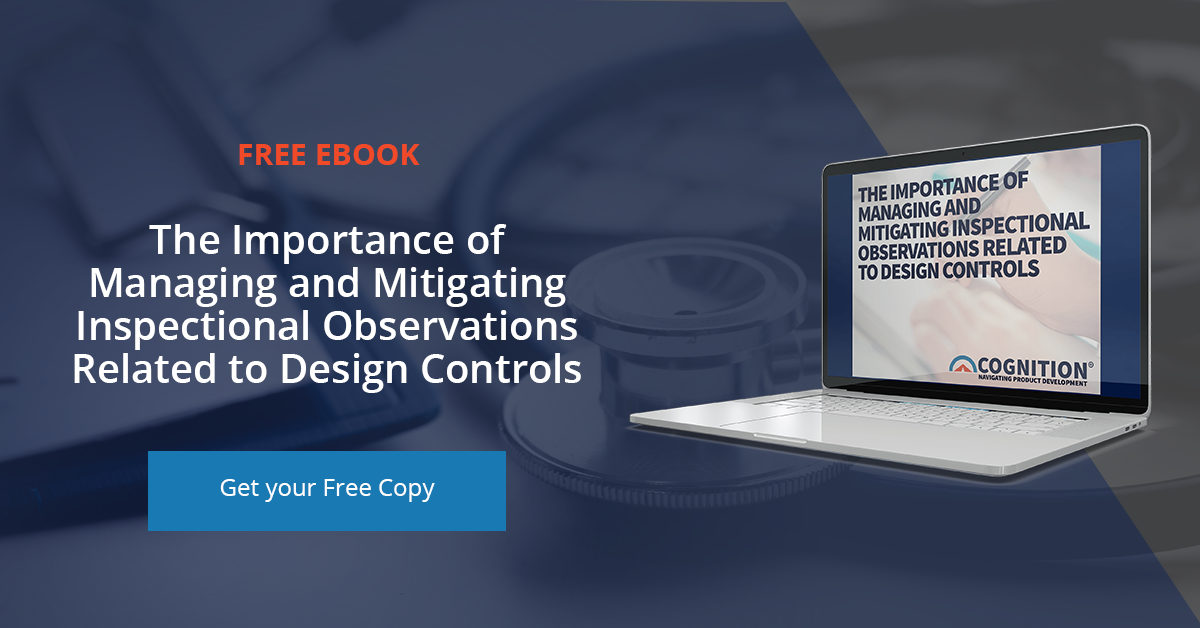3 Reasons to Worry about FDA Form 483s for Design Controls
In life science industries, many believe that regulatory inspections are focused more on postmarket activities. This attitude isn’t surprising; however, its results can be detrimental. Many companies elect to focus on bolstering their postmarket compliance, allowing other regulatory activities such as design controls to lapse or deteriorate over time. Unfortunately for these companies, the truth about regulatory inspections is starkly different than their beliefs, and that can come back to haunt them.
In FY2017, inspectional observations for medical devices saw citations for nearly every part of FDA’s Design Controls Regulation. Of the 1,030 device observations from FY2017, 438 were Design Controls citations. This data tells us one important thing: FDA is keeping an eye on more than just postmarket compliance, and companies need to be closely surveying their design control activities. Otherwise, there are three pain points that affect your life science organization.
Time & Resources
 Developing and submitting responses to 483s takes a considerable amount of time and effort, in addition to the resulting corrective action you commit to. Especially in life science industries where time to market is crucial for everyone, that loss of time can set back other project timelines and result in lost resources and revenue. Not only does this influence your bottom line, but it can also have a downstream effect on patients; the longer that novel treatments, diagnostics, and devices are delayed, the longer patients have to deal with their conditions.
Developing and submitting responses to 483s takes a considerable amount of time and effort, in addition to the resulting corrective action you commit to. Especially in life science industries where time to market is crucial for everyone, that loss of time can set back other project timelines and result in lost resources and revenue. Not only does this influence your bottom line, but it can also have a downstream effect on patients; the longer that novel treatments, diagnostics, and devices are delayed, the longer patients have to deal with their conditions.
A 483 can be depleting to your organization’s resources as well as time—both in the response and other adverse results. The diversion of personnel, tools, and equipment to successfully enact the corrective action committed to in the response can put a strain on already thin budgets, especially for smaller organizations. Likewise, the publication of your warning letter can negatively alter your brand status and value, dissuading consumers from your products and services.
Product Design Issues
 Design issues happen throughout the product development process, but when caught early, they can be more easily corrected. In the event an inspection brings up major concerns with the product design—especially for any of your legally marketed products—there’s no telling how intensive the resulting remediation could be.
Design issues happen throughout the product development process, but when caught early, they can be more easily corrected. In the event an inspection brings up major concerns with the product design—especially for any of your legally marketed products—there’s no telling how intensive the resulting remediation could be.
In a best-case scenario, product design issues could be resolved through such avenues as:
- Product updates (i.e., software)
- Information for safety
- Warning labels
- Production & issuance of additional parts
While it’s tempting to hope for a simple resolution to issues in your product’s design, chances are good that your remediation activities might be more involved. Product recalls, for example, cost significant time and resources to resolve. And, in extreme cases, remediation that reveals fundamental design flaws can result in both marketed and in-development products having to go back to the drawing board.
Quality System Issues
If your organization receives a related citation, there’s a good chance you’ll have to start assessing the impact of that breakdown throughout your quality system. Ineffective, incomplete, or absent design controls activities could affect everything from risk management and manufacturing to postmarket surveillance. These issues might not even be apparent until a 483 is handed down, so whatever remediation it takes to correct them first needs to identify any influence they’ve had on the quality system.
 When breakdowns occur in your design control activities, it could have serious ripple effects. Identifying and controlling these before they become far more serious requires vigilance and proactive approaches. A thorough and appropriate program for remediation can mitigate time and resource costs, and regular monitoring can work toward spotting issues in the product design and your quality system. The best approach to dealing with FDA Form 483s is to avoid them altogether when possible, and the combination of activities and approaches that fit your organization best can help you achieve that goal.
When breakdowns occur in your design control activities, it could have serious ripple effects. Identifying and controlling these before they become far more serious requires vigilance and proactive approaches. A thorough and appropriate program for remediation can mitigate time and resource costs, and regular monitoring can work toward spotting issues in the product design and your quality system. The best approach to dealing with FDA Form 483s is to avoid them altogether when possible, and the combination of activities and approaches that fit your organization best can help you achieve that goal.
About Cognition Corporation
At Cognition, our goal is to provide medical device and pharmaceutical companies with collaborative solutions to the compliance problems they face every day, allowing the customer to focus on their products rather than the system used to create them. We know we are successful when our customers have seamlessly integrated a quality system, making day-to-day compliance effortless and freeing up resources to focus on product safety and efficacy.





